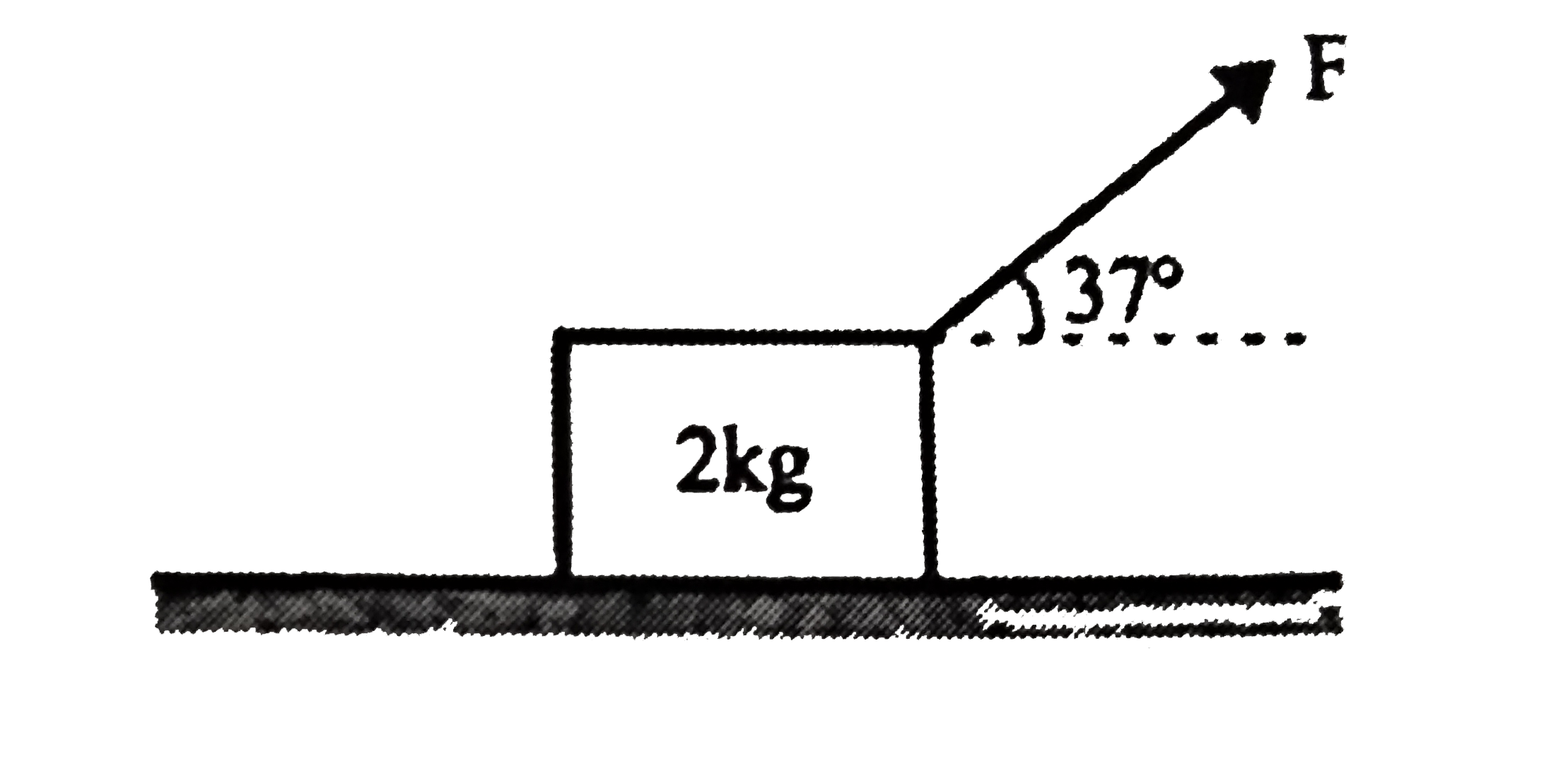A blocky of mass m rests on a horizotal floor with which it has a coefficient of static friction It is desired to make the body move by applying the minimum possible force F. Find the magnitude of F and the direction in which it has be applies.
To solve the problem of finding the minimum force F required to move a block of mass m resting on a horizontal floor with a coefficient of static friction μ, we can follow these steps:
1. Identify Forces Acting on the Block:
- The weight of the block W=mg acts downward.
- The normal force N acts upward.
- The static friction force fs acts opposite to the direction of applied force F.
2. Set Up the Equations:
- The vertical forces must balance:
N+Fsinθ=mg
- The horizontal forces must satisfy:
Fcosθ≥fs
- The maximum static friction force is given by:
fs=μN
3. Substituting for Normal Force:
- From the vertical force balance, we can express N:
N=mg−Fsinθ
4. Substituting into the Friction Equation:
- Replace N in the friction equation:
Fcosθ≥μ(mg−Fsinθ)
5. Rearranging the Inequality:
- Rearranging gives:
Fcosθ+μFsinθ≥μmg
- Factor out F:
F(cosθ+μsinθ)≥μmg
6. Solving for F:
- Thus, we can express F as:
F≥μmgcosθ+μsinθ
7. Minimizing F:
- To find the minimum force, we need to maximize the denominator cosθ+μsinθ.
- Differentiate y=cosθ+μsinθ with respect to θ and set the derivative to zero:
dydθ=−sinθ+μcosθ=0
- This leads to:
μ=tanθ
8. Finding the Maximum Value:
- Using the identity 1+tan2θ=sec2θ:
cosθ=1√1+μ2,sinθ=μ√1+μ2
- Substitute these into the expression for F:
F≥μmg1√1+μ2+μ⋅μ√1+μ2
- Simplifying gives:
F≥μmg1+μ2√1+μ2=μmg√1+μ21+μ2
9. Final Result:
- The minimum force F required to move the block is:
F=μmg√1+μ2
- The weight of the block W=mg acts downward.
- The normal force N acts upward.
- The static friction force fs acts opposite to the direction of applied force F.
- The vertical forces must balance:
N+Fsinθ=mg
- The horizontal forces must satisfy:
Fcosθ≥fs
- The maximum static friction force is given by:
fs=μN
- From the vertical force balance, we can express N:
N=mg−Fsinθ
- Replace N in the friction equation:
Fcosθ≥μ(mg−Fsinθ)
- Rearranging gives:
Fcosθ+μFsinθ≥μmg
- Factor out F:
F(cosθ+μsinθ)≥μmg
- Thus, we can express F as:
F≥μmgcosθ+μsinθ
- To find the minimum force, we need to maximize the denominator cosθ+μsinθ.
- Differentiate y=cosθ+μsinθ with respect to θ and set the derivative to zero:
dydθ=−sinθ+μcosθ=0
- This leads to:
μ=tanθ
- Using the identity 1+tan2θ=sec2θ:
cosθ=1√1+μ2,sinθ=μ√1+μ2
- Substitute these into the expression for F:
F≥μmg1√1+μ2+μ⋅μ√1+μ2
- Simplifying gives:
F≥μmg1+μ2√1+μ2=μmg√1+μ21+μ2
- The minimum force F required to move the block is:
F=μmg√1+μ2
Topper's Solved these Questions
- NEWTON'S LAWS OF MOTION & FRICTIONBook:ALLENChapter:NEWTON'S LAWS OF MOTION & FRICTIONExercise:EXERCISE (S-1)
Explore 26 Videos
- NEWTON'S LAWS OF MOTION & FRICTIONBook:ALLENChapter:NEWTON'S LAWS OF MOTION & FRICTIONExercise:EXERCISE (S-2)
Explore 9 Videos
- MOTION IN A PALNEBook:ALLENChapter:MOTION IN A PALNEExercise:SOLVED EXAMPLE
Explore 28 Videos
- NEWTONS LAWS OF MOTIONBook:ALLENChapter:NEWTONS LAWS OF MOTIONExercise:EXERCISE-III
Explore 28 Videos
Similar Questions
A particle of mass m rests on a horizontal floor with which it has a coefficient of static friction μ. It is desired to make the body move by applying the minimum possible force F. Find the magnitude of F and the direction in which it has to be applied.
View SolutionA body of mass 1 kg rests on a horizontal floor with which it has a coefficient of static friction 1√3. It is desired to make the body move by applying the minimum possible force FN. The value of F will be ________. (Round off to the Nearest Integer)
[Take g=10ms−2]
View Solution
Knowledge Check
A blocky of mass m rests on a horizotal floor with which it has a coefficient of static friction μ. It is desired to make the body move by applying the minimum possible force F. Find the magnitude of F and the direction in which it has be applies.
AμmgB√1+μ2μmgCμ√1+μ2mgDμmg√1+μ2A block of mass 2 kg is kept on a rough horizontal floor an pulled with a force F. If the coefficient of friction is 0.5. then the minimum force required to move the block is :-
 A10 NB10011NC1008ND20 N
A10 NB10011NC1008ND20 NA homogeneous block rests against a vertical wall for which the coefficient of friction is 1/2. A force 'F' is applied to the block in the direction as shown in figure. Find the maximum magnitude of applied force 'F' such that block remains in rest.
 AmgB5mgCmg/5Dmg/2
AmgB5mgCmg/5Dmg/2
A body of mass m rests on a horizontal rough platform. Coefficient of static friction is u. Calculate the minimum possible force required to move the body along the platform.
View SolutionA block of mass m rests on a horizontal floor for which coefficient of friction is μ . Find the magnitude and the direction of force that should be applied to just move the block so that the applied force is minimum.
View SolutionA block of mass m is kept on a horizontal table. If the static friction coefficient is μ., find the frictional force acting on the block.
View SolutionA block of mass M is kept on as rough horizontal surface. The coefficient of static frictionbetween the block and the surface is μ. The block is to be pulled by applying a force to it. What minimum force is needed to slide the block? In which direction should this force act?
View SolutionA block of mass m is lying on horizontal surface of coefficient of friction μ. A force is applied to the block at an angle θ with the horizontal. The block will move with a minimum force F if
View Solution